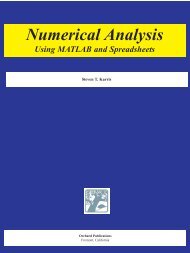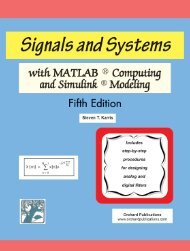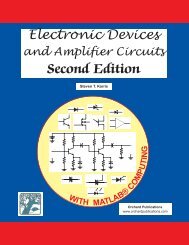endof-
Signals & Systems Front Cover FOURTH.qxp - Orchard Publications
Signals & Systems Front Cover FOURTH.qxp - Orchard Publications
You also want an ePaper? Increase the reach of your titles
YUMPU automatically turns print PDFs into web optimized ePapers that Google loves.
Chapter 10 The DFT and the FFT Algorithmand it is used with the nodes where two solid lines terminate on them. The number inside thecircles denote the power of W N , and the minus (−) sign below serves as a reminder that thebracketed term of the second equation involves a subtraction. Using this graph and the aboveequations, compute the frequency component X[ 3]. Verify that this is the same as in Example10.5.x0 [ ]X0 [ ]x1 [ ]x2 [ ]x3 [ ]W 0W 2 −W 3 W 0− W 0− W 2 − W 0W 0W 1− W 0W 2 − W 0x4 [ ]x5 [ ]x6 [ ]x7 [ ]−−−− − −X1 [ ]X5 [ ]X3 [ ]X7 [ ]6. Plot the Fourier transform of the rectangular pulse shown below, using the MATLAB fft function.Then, use the ifft function to verify that the inverse transformation produces the rectangularpulse.ft ()1X4 [ ]X2 [ ]X6 [ ]−1 0 1t7. Plot the Fourier transform of the triangular pulse shown below using the MATLAB fft function.Then, use the ifft function to verify that the inverse transformation produces the rectangularpulse.ft ()1−1 0 1t10−32Signals and Systems with MATLAB ® Computing and Simulink ® Modeling, Fourth EditionCopyright © Orchard Publications







